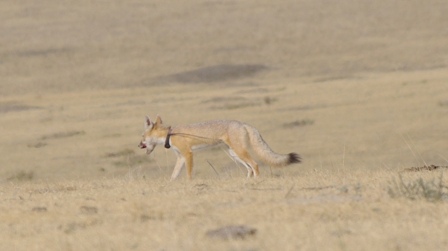 2012 Swift Fox Project
2012 Swift Fox Project2012 Final Swift Fox Project Report to BIA
Reporting: Robert Goodman, Mr. Michael Thompson and Dr. Trudy Ecoffey, Biologist Oglala Sioux Parks and Recreation Authority
Introduction
The Oglala Sioux Tribe through the Oglala Sioux Parks and Recreation Authority (OSPRA) has designated the reintroduction of the swift fox (Vulpes velox) as a major environmental priority. The swift fox is an important species that did and can again play an integral role on the Pine Ridge Indian Reservation ecosystem. In addition, the swift fox holds tremendous cultural significance to the Lakota people. Through oral tradition and Euro-American accounts it has been well documented that the (SUNGILA TOKALA) Kit-Fox Society (the Lakota make no distinction between the swift fox and its kit fox cousin) played an integral part of Lakota culture and was the most prominent of all warrior societies.
Swift fox were once abundant throughout the Great Plains. They were nearly extirpated from the Plains by 1900 because of predator and rodent control programs involving the use of poisons, trapping, and hunting, and to the destruction of native prairie habitat. The swift fox was a candidate for protection under the Endangered Species Act from 1995-2001. Post-1950 species accounts suggest that swift fox populations have been increasing and reoccupying some portions of their native range in the United States. The U.S. Fish and Wildlife Service believe that the swift fox remains in approximately 40% of its range.
Sources from tribal elders indicated that there were numerous accounts of swift fox on the Pine Ridge Reservation from its inception in the 1890s to the mid-1970s. However, recent surveys for swift fox in western Shannon County on the Pine Ridge Indian Reservation have yielded mixed results. McDaniel (1975) reported no less than five active den sites and nine visual observations of swift foxes north of Oglala, South Dakota. In 1995, Kruse et al. were unable to observe swift foxes in the same locale but noted a high incidence of other canids (coyotes and red fox). Several experts attribute the swift fox decline in the 1980s to the Oglala Sioux Tribe’s poisoning of prairie dogs in the area that produced a rapid decline in prey although no research was conducted on the swift fox population during this time (Uresk, D. W. personal interview, September 3, 2003). Dateo et al. (1996) did make a visual sighting of a single swift fox near Oglala. During the Pine Ridge Reservation Swift Fox Survey in 2005-2007, there was only one confirmed swift fox location (Final Report USFWS, OSPRA 2007)
In 2005-2007, Oglala Sioux Parks and Recreation Authority Biology and Research Division did an extensive search to see if a viable population of swift fox presides on the Pine Ridge Reservation. No active dens were found and only two foxes were found in the study. In 2009, Oglala Sioux Parks and Recreation Authority Biology and Research Division translocated 54 swift fox (Vulpes velox) from Colorado and Wyoming. In 2010, 25 foxes from Colorado were translocated to Pine Ridge Reservation. Both studies for these projects were funded through the USFWS Tribal Wildlife Grant and funding from BIA. Monitoring continues through spotlighting, as well as aerial, and ground telemetry
OSPRA continued to monitor Swift Fox on the Pine Ridge Indian Reservation. This is a report of those activities.
Activities
Translocation Efforts –
In the Fall of 2010, with the cooperation and assistance from Colorado Dept. of Wildlife, OSPRA personnel translocated 25 Swift fox from the Lamar, CO area. These were released in the same area of the PRIR as the 54 swift fox translocated the previous year from WY and the Pawnee National Grasslands of CO.
OSPRA with crews from the Colorado Game and Fish program, trapped three nights with an average of 80 traps per night to log 240 trap nights with 25 foxes being trapped. All foxes were collared, AVID chipped, vaccinated, health checked by the Colorado Department of Wildlife veterinarian and then transported. Proper documentation with the both the Colorado and South Dakota Animal Health Board was completed.

Those fox released in 2010 were not “soft released” as those of 2009 were. OSPRA believed that finding sign of other swift fox in the area had more to do with release success than the type of release. For this reason, personnel attempted to find previously or currently used dens to release fox into and did not construct “soft release” pens.
VHF monitoring
VHF monitoring served as the main method of locating live fox and mortalities. Most VHF monitoring was carried out at night by teams in vehicles. Searches concentrated on areas known previously to have swift fox/swift fox dens. Searching continued outside of these “core areas” with little success. Most fox were found in one central area. Locating fox by VHF served to guide live trap placement in the Fall of the year.
Difficulties encountered included: extreme weather, extreme terrain, and cost of fuel. Often excessive snow or muddy terrain would limit ability to access areas. In later summer 2012, crews had to be careful to prevent fires as a record drought caused extremely high fire dangers and limited travel to short-grass areas.
Aerial Flights
In order to locate fox that had gone off the Reservation or to areas hard to access by vehicle, OSPRA employed an aerial telemetry strategy. OSPRA hired the South Dakota Civil Air Patrol to conduct flights. A total of four flights have been made. These flights did locate fox not previously detected after their release. With results from these flights personnel could more effectively target areas for Fall trapping.
|
Flight |
Date |
Non Mortality Signals |
Mortality Signals |
Off Reservation |
Total |
|
1 |
3/1/2010 |
4 |
2 |
1 |
7 |
|
2 |
5/25/2010 |
5 |
0 |
1 |
6 |
|
3 |
1/24/2011 |
5 |
1 |
1 |
7 |
|
4 |
4/24/2012 |
1 |
5 |
0 |
6 |
|
|
|
|
|
|
|
|
|
|
|
|
|
|
The flights were extremely helpful in locating mortalities. Of the eight mortality signals detected, 5 were recovered and proven to be, in fact, actual mortalities. Occasionally errant signals were detected and this created the need to check signals with vehicle VHF to verify if they were fox signals or errant VHF signals.
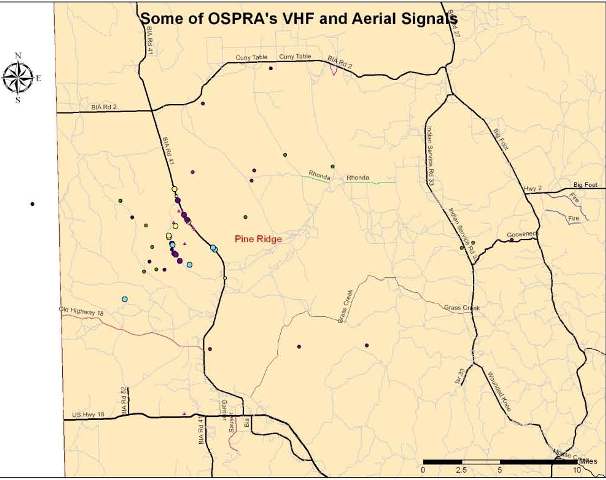
Incidental Sightings
Several reports were taken on sightings by the public. At least two confirmed reports were taken from the public. Also, two mortalities were found by the public and also two unconfirmed mortalities (carcasses not found). OSPRA personnel also kept track of sightings of fox. If a signal could be detected from the fox it was recorded as a signal detection not an incidental sighting.
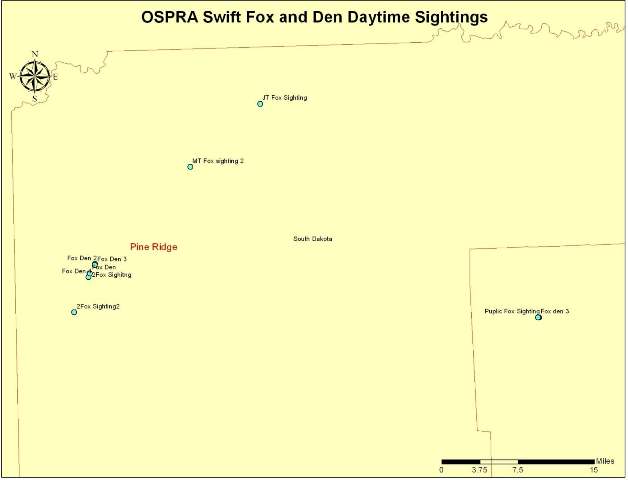
Spotlighting
Spotlighting was conducted 1 or 2 nights per month for at least 6-10 hours per night. Depending on weather and road conditions, this was approximately 40 nights of spotlighting for two the last two years (2011 and 2012) This was done primarily done in conjunction with VHF searches. As crews drove the areas listening to VHF, they would also search using spotlights. This technique was crucial in finding fox that were not collared-such as pups. The technique also proved to be safer than nighttime VHF-only surveys because crews could better see the terrain and obstacles at night. When crews spotted a fox in the spotlight, they would watch the individual and try to hear a VHF signal from the individual. Often this would lead to the sighting of other swift fox or locations of dens.
Motion Cameras
OSPRA was able to borrow 20 motion cameras from World Wildlife Fund and use them for the project. Over 80 separate settings were made with each setting lasting a minimum of 3 nights. This resulted in more than 240 trap-nights. Fifteen separate settings recorded swift fox. Motion camera use enabled OSPRA to monitor the swift fox project area without having to use as much fuel and as many man-hours. Although the successful photography of swift fox was limited to areas already known to have fox, the photos gave important clues as to hours of activity and predators and prey frequenting the area. Other animals recorded included: bobcat, coyote, badger, skunk, birds, cottontail rabbits, raccoons, mice, antelope, deer and domestic livestock.
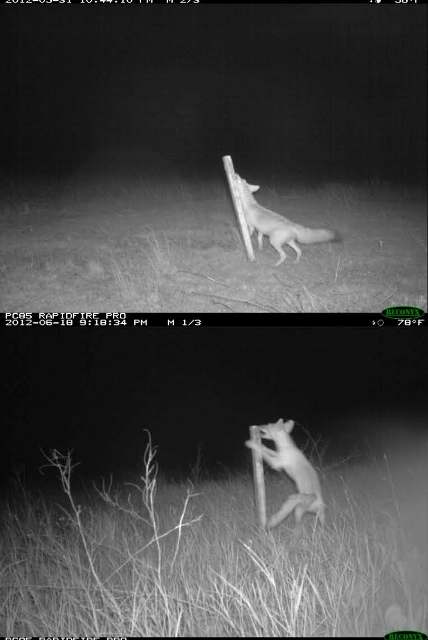
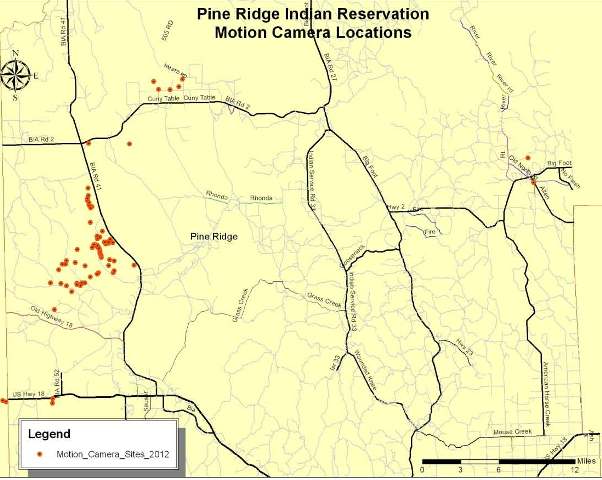
Live Trapping
2010
In 2010, OSPRA trapped for 3 nights to equal 125 trap nights. OSPRA was able to trap 9 fox pups. Most of this trapping was done in an area not as large as the 2011 and 2012 two trapping seasons. Also, OSPRA personnel recorded “missed” fox. That is, a number were recorded at a den and then a lesser number were trapped from that den. A total of 10 untrapped fox were observed.
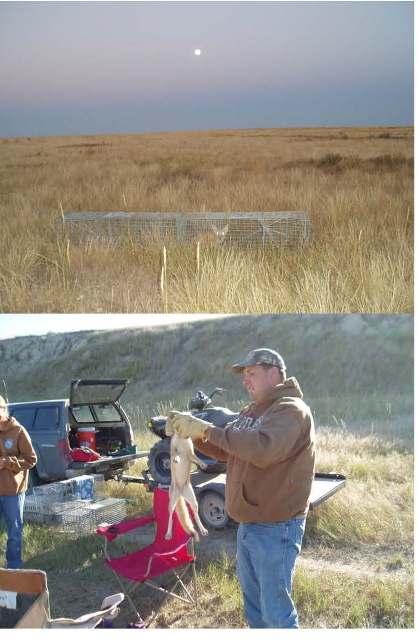
2011
In 2011 OSPRA was able to trap 5 separate nights. A larger area was trapped due to discoveries of aerial surveys and ground telemetry earlier in the season. This resulted in 123 trap nights and 11 captures. Of those captures, one escaped during handling before being collared or otherwise marked. Two of the captures were recaptures. One recapture was from the Pawnee group of 2009 and one was from the Lamar group of 2010. These are the only recaptures that OSPRA has ever accomplished. Again, on these trappings, a minimum of nine more untrapped fox were recorded. This has given us hope that there are more fox than what we were able to actually trap and document.
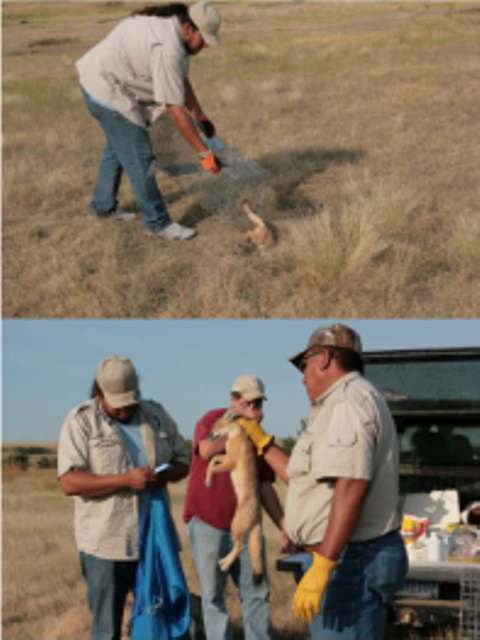
2012
OSPRA was only able to live trap for only 2 trap nights. However we did deploy more traps than we had in previous years. We logged 102 trap nights. This resulted in only one capture.

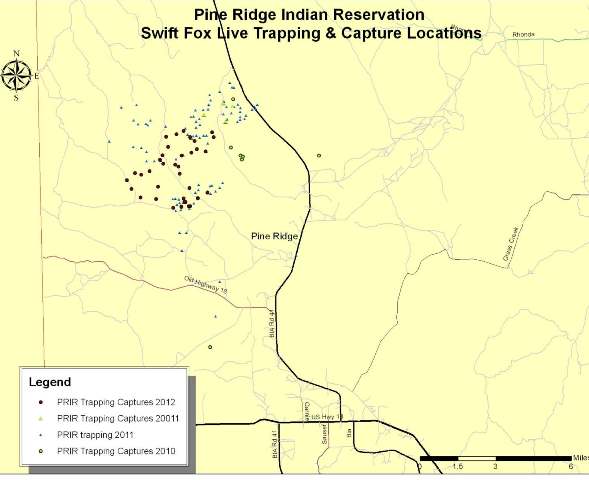
Current Status
If all fox that OSPRA has translocated, trapped on the Reservation, and observed (but not collared) are alive, the population could be 93 fox. However we do not believe that is the case. Those foxes translocated from CO and WY are past their life expectancy. We have instances where we were able to detect a mortality signal and not locate the mortality later. Those individual fox were not listed as deceased although we suspect they are. The last detection (trapping) of a live fox was in August of 2012. We did not detect (trapping spotlighting or VHF signal) any other live fox since that date. We suspect there are more but further monitoring efforts are needed.

Future Plans
The goal of OSPRA’s reintroduction is to have a viable population on the Pine Ridge Indian Reservation and also to be a source or “bridge” for dispersals of neighboring populations such as that of Badlands National Park and the population near Ardmore, SD on the Buffalo Gap National Grasslands. It is the hope of OSPRA that the population will grow into one population of the southwestern South Dakota instead of 3 small isolated populations.
OSPRA will continue to seek funding to expand the Swift fox program. If funds are secured, OSPRA will continue to monitor fox in much the same way as has been done. Changes might include utilizing motion cameras more so as to reduce fuel and man-hour costs. With enough funding, VHF monitoring efforts may be increased also. OSPRA has also discussed translocating pups from the nearby and successful Badlands National Park population of reintroduced fox. With proper funding this might again be explored.